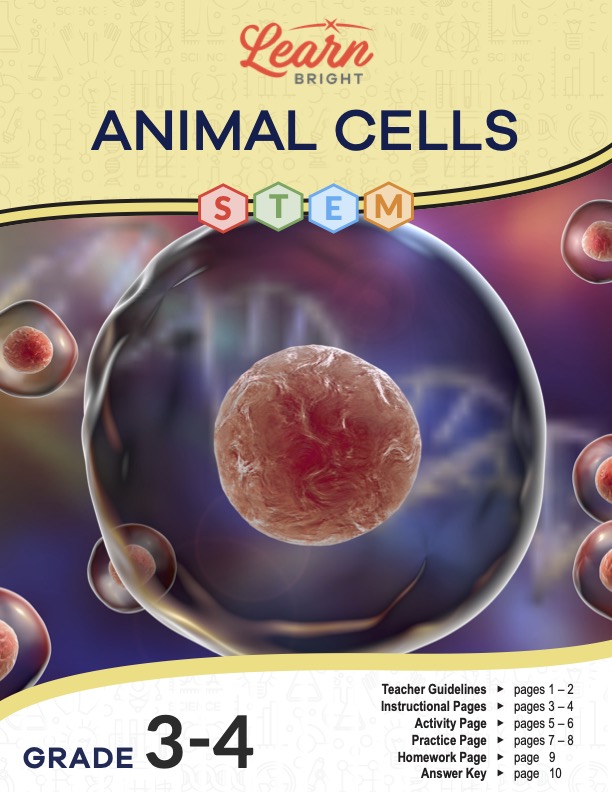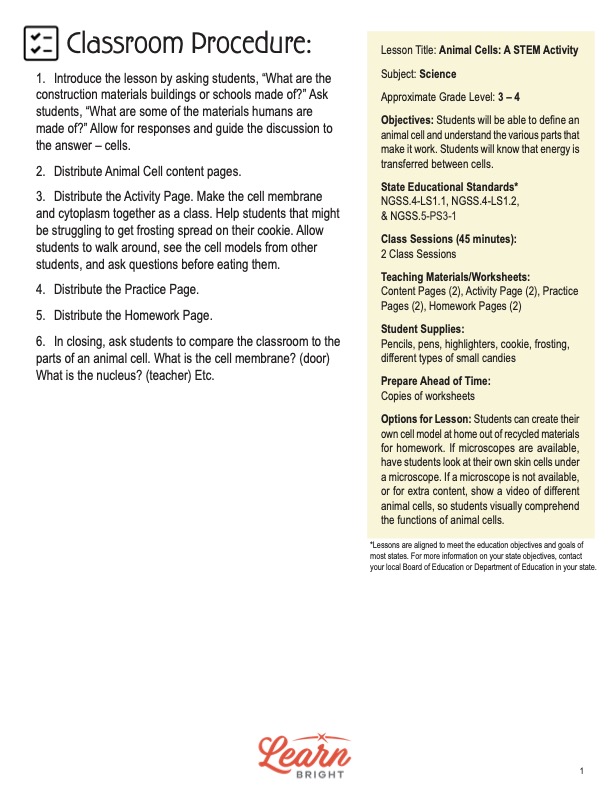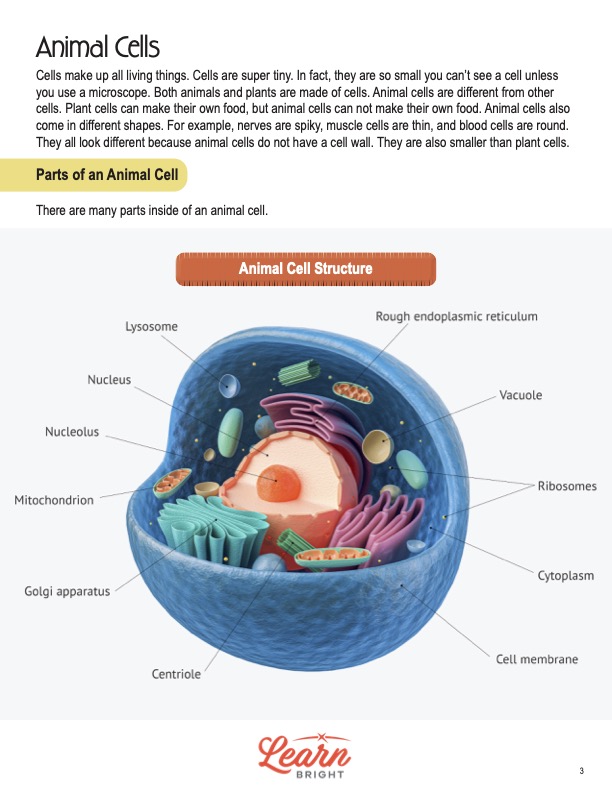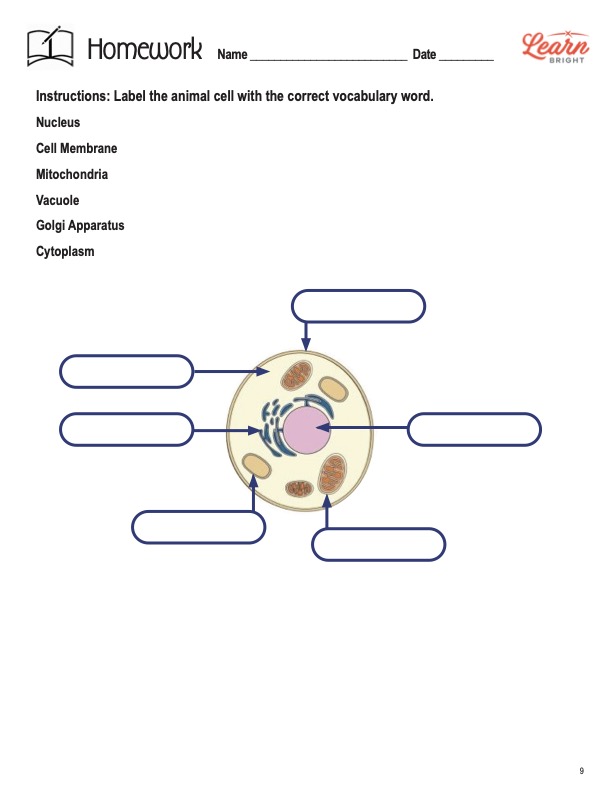Description
What our Animal Cells STEM lesson plan includes
Lesson Objectives and Overview: Animal Cells STEM explores the various components within the cell of an animal. Students will learn what the functions are for each different component. They will also discover how energy transfers between cells. This lesson is for students in 3rd grade and 4th grade.
Classroom Procedure
Every lesson plan provides you with a classroom procedure page that outlines a step-by-step guide to follow. You do not have to follow the guide exactly. The guide helps you organize the lesson and details when to hand out worksheets. It also lists information in the yellow box that you might find useful. You will find the lesson objectives, state standards, and number of class sessions the lesson should take to complete in this area. In addition, it describes the supplies you will need as well as what and how you need to prepare beforehand. For this lesson, you will need pencils, pens, highlighters, cookies, frosting, and different types of small candies.
Options for Lesson
There are a number of suggestions in the “Options for Lesson” section of the classroom procedure page that you could incorporate into the lesson. One idea is for students to create their own cell models at home out of recycled materials as an extra homework assignment. If you have access to microscopes, students could look at their own skin cells under the microscope. Another idea is to show a video of the cells of different animals. The goal is for student to comprehend the functions of cells.
Teacher Notes
The teacher notes page provides an extra paragraph of information to help guide the lesson and remind you what to focus on. The blank lines on this page are available for you to write out thoughts and ideas you have as you prepare the lesson.
ANIMAL CELLS STEM LESSON PLAN CONTENT PAGES
Animal Cells
The Animal Cells STEM lesson plan contains two content pages. To start off, the lesson reminds students that cells make up all living things. They are so tiny that we can only see them with the help of a microscope. Even though cells make up every living thing, not all cells are the same. Plants cells, for instance, differ from animal cells.
The cells inside plants allow them to make their own food. Animal cells, however, cannot make their own food. They also come in different shapes. For example, a nerve cell is spiky, a muscle cell is thin, and blood cells are round. They all look different because they have no cell wall (which plant cells do have) to provide a uniform structure. In addition, animal cells are smaller than plant cells.
On the first page is a diagram of a cell and its various parts. These parts include the nucleus, Golgi apparatus, cell membrane, ribosomes, and vacuoles. The lesson will not detail the functions of every single cell part. However, it will provide information on some of the most important parts and focus on those parts throughout the lesson.
Parts of a Cell
The second page describes the functions of the six parts that students will focus on throughout the lesson. These parts are the nucleus, mitochondria, vacuole, Golgi apparatus, cell membrane, and cytoplasm. Students can reference the first content page to find where these parts are in the cell diagram.
First, students will learn about the nucleus, which is the part that controls the cells just as the brain controls the body. It ensure continuous activity within the cell and gives all the other parts directions on what to do and when. Without the nucleus, a cell could not function. If the cell needs a part, the nucleus can make it. The nucleus is also where we find the body’s DNA information.
Mitochondria are the powerhouses of the cell. They break down and convert sugar into energy, which is what the cell uses to do its job. If the nucleus is like a brain, mitochondria are like the stomach. And like our house has storage, cells do too. Vacuoles are storage spaces for cells to put extra food, water, or waste. Depending on the function of the cell, it can have one or several vacuoles.
The Golgi apparatus looks like a layered, flat sack. Located near the nucleus, it helps make, store, pack, and transport particles throughout the cell. Next, the cell membrane protects the whole cell by keeping out harmful things. It’s like a guard that only lets the good guys into the castle. Finally, cytoplasm is the cell’s filling. It helps a cell keep its shape despite the lack of a wall and keeps all the other parts in the right places.
ANIMAL CELLS STEM LESSON PLAN WORKSHEETS
The Animal Cells STEM lesson plan includes three worksheets: an activity worksheet, a practice worksheet, and a homework assignment. Each one will help students solidify their grasp of the material they learned throughout the lesson. You can refer to the classroom procedure guidelines to know when to hand out each worksheet.
COOKIE MODEL ACTIVITY WORKSHEET
Students will really enjoy the activity for this lesson since they get to create a model of a cell with cookies! First, students will spread frosting on their round cookies. They will write down what both the frosting and the outer edge of the cookie represent. In the box on the worksheet, they will design a key for their model as they make it. The cookies should have a nucleus, a Golgi apparatus, mitochondria, and vacuoles. Students will represent those parts with the various cookie decorations, such as an M&M for the nucleus and sprinkles for the mitochondria. Once they complete their cookie model, they will draw a picture of it on the worksheet.
ANIMAL CELLS STEM PRACTICE WORKSHEET
The practice worksheet requires students to remember the functions of each of the six animal cell parts that they learned about. The worksheet lists the parts and their functions. Students will cut out all the slips and match the components with their correct functions.
LABEL THE CELL HOMEWORK ASSIGNMENT
For the homework assignment, students will label the six parts of a cell. You can choose whether or not they can use the content pages for reference. You could also make this assignment a quiz to do in class to test their memory.
Worksheet Answer Keys
The lesson provides answer keys for the three worksheet assignments. The correct responses are in red to make it easy to compare with students’ work. For both the practice and homework worksheets, students’ responses should match exactly. However, the activity answer key simply provides the correct answers for two the fill-in-the-blank statements. The remainder of the assignment will vary from student to student. If you choose to administer the lesson pages to your students via PDF, you will need to save a new file that omits these pages. Otherwise, you can simply print out the applicable pages and keep these as reference for yourself when grading assignments.









